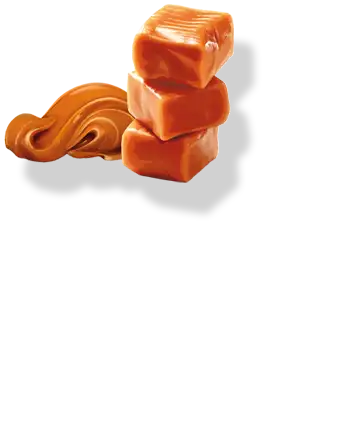A Sticky, Sweet Celebration
Caramel: the golden, gooey confection that has stolen hearts (and a few dental fillings) for centuries. Every year on April 5th, sweet tooths across the nation unite in celebration of National Caramel Day, an occasion dedicated to honoring the velvety, buttery goodness that has elevated everything from popcorn to coffee. Whether drizzled over ice cream, layered in candy bars, or simply devoured straight from the spoon, caramel deserves its own holiday, and we're here to pay tribute to this sticky superstar.

A Brief History of Caramel (Because It Deserves Recognition)
Caramel's origins date back as far as 1000 A.D., when Arab cultures first discovered the magic of cooking sugar with water to create a sticky, sweet treat. It didn’t take long for this delectable invention to travel across continents, evolving into the rich, smooth confection we know today. By the 19th century, American candy makers had perfected the process, adding milk and butter to create the creamy caramel that became the foundation for beloved sweets like caramel apples, toffees, and even the iconic Werther’s Original (your grandma’s favorite, of course).
The Science Behind the Sweetness
At the heart of caramel's irresistible allure is a fascinating chemical ballet known as the Maillard reaction, a culinary phenomenon that transforms the ordinary into the extraordinary. When sugar is heated, it doesn't just melt; it undergoes a complex process of decomposition and recombination, a sort of molecular makeover that gives birth to caramel's signature golden hue and rich flavor palette.
- The Transformation Begins: The journey from sugar to caramel starts at around 320°F (160°C), when sugar molecules (sucrose) break down into simpler sugars, glucose, and fructose. As the heat intensifies, these sugars begin to react with each other in a series of dehydration reactions, releasing water and forming new compounds that contribute to the deep flavors and aromas of caramel.
- A Symphony of Flavors: This process is not a one-note melody but a symphony of flavors. The initial sweetness of caramel gradually gives way to more nuanced notes – hints of butter, a touch of bitterness, and even smoky undertones in darker caramels. This complexity is the result of hundreds of different compounds that form as the sugar transforms, creating a rich tapestry of taste that tantalizes the palate.
- The Role of Fats and Dairy: While sugar is the star of the show, caramel's supporting cast – butter and cream – play crucial roles in shaping its texture and flavor. Butter adds richness and depth, while cream introduces a silky smoothness that makes caramel so luxuriously indulgent. These dairy components also participate in the Maillard reaction, their proteins and fats interacting with the sugars to add even more layers of flavor.
- Perfecting the Art: Creating the perfect caramel is as much an art as it is a science. The temperature and timing need to be precise; too little heat, and you have a sweet syrup; too much, and you're left with a bitter, burnt mess. The ideal caramel strikes a balance between sweetness and complexity, achieving a harmony of flavors that is both rich and nuanced.
- Caramel in Culinary Creations: Beyond its role as a standalone treat, caramel's versatility shines in the culinary world. It can elevate desserts from ordinary to extraordinary, adding depth to cakes, a smooth finish to ice creams, and a tempting allure to chocolates. Its application isn't limited to sweets; caramel's rich flavor profile can also enhance savory dishes, countering saltiness and acidity.
Understanding the science behind caramel deepens our appreciation for this confection and invites us to experiment in our kitchens. Whether you're aiming for a light, buttery caramel or a dark, intense one, mastering the chemistry of caramel allows you to play with flavors and textures, turning simple ingredients into something truly magical. So, the next time you savor a piece of caramel, take a moment to appreciate the complex chemical journey that brought this sweet delight to your taste buds.
 Caramel’s Many Forms
Caramel’s Many Forms
Caramel isn’t just one thing—it’s a whole family of decadent delights. Here’s a quick guide to some of caramel’s best variations:
- Soft Caramel – Perfectly chewy and buttery, this variety is the base for many candies and chocolates.
- Salted Caramel – The perfect marriage of sweet and salty, proving once and for all that opposites attract.
- Caramel Sauce – Best enjoyed drizzled over ice cream, pancakes, or straight into your mouth (we won’t judge).
- Caramel Popcorn – The snack that turns every movie night into a gourmet experience.
- Toffee – A firmer, crunchier cousin of caramel that’s often loaded with nuts and covered in chocolate.
- Dulce de Leche – The Latin American version, made by slowly simmering milk and sugar until it becomes a thick, caramelized dream.
How to Celebrate National Caramel Day (Without Getting Stuck to Everything)
National Caramel Day is the perfect excuse to indulge in this sweet delight in all its glorious forms. Whether you prefer your caramel smooth and creamy or crunchy and rich, there are plenty of ways to honor this delicious occasion. Here are some fun and tasty ways to celebrate:
- Indulge in Your Favorite Caramel Treat – Whether it’s a caramel macchiato, a Snickers bar, or homemade caramel candies, today is the day to go all in.
- Try Making Caramel at Home – With just sugar, butter, and cream, you can create your own batch of liquid gold. Just be careful—boiling sugar is as dangerous as it is delicious.
- Gift Some Caramel Goodies – Share the sweetness with friends, coworkers, or unsuspecting strangers who look like they need a sugar boost.
- Experiment with Caramel Pairings – Caramel goes beautifully with chocolate, coffee, apples, and even a sprinkle of sea salt. Get creative!
- Give a Nod to Caramel in Pop Culture – Watch Willy Wonka & the Chocolate Factory, listen to "Sugar, Sugar" by The Archies, or scroll through caramel-laden recipes on Instagram for inspiration.
Sticky Facts
Caramel is more than just a sweet treat—it's a fascinating confection with a rich history and unique characteristics. Here are some intriguing facts to sweeten your knowledge:
- Caramel was originally made by boiling sugar and water, but adding butter and cream turned it into the luscious treat we love today.
- The word "caramel" is derived from the Latin word "cannamellis," meaning "sugar cane and honey."
- Caramel apples became a fall staple in the early 1900s when candy makers experimented with dipping apples in melted caramel.
- Salted caramel was made famous in the early 2000s by French pastry chef Pierre Hermé, and the trend has only grown sweeter since.
- A single strand of caramel can stretch up to three feet before it breaks—talk about a sweet stretch!
National Caramel Day isn’t just another excuse to eat sweets (though it certainly works for that). It’s a day to appreciate the craftsmanship, science, and joy that caramel brings to the world. So whether you’re a casual caramel enthusiast or a full-blown fanatic, take a moment to savor this sweet, buttery delight. And remember, caramel may be sticky, but the happiness it brings is definitely worth the mess!
Please Share our Content







 Caramel’s Many Forms
Caramel’s Many Forms








 "Sláinte!" is a traditional Irish expression used as a toast, equivalent to "Cheers!" in English.
"Sláinte!" is a traditional Irish expression used as a toast, equivalent to "Cheers!" in English.